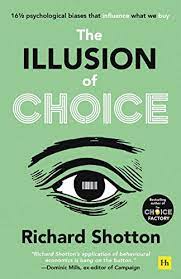The one-sentence summary
Businesses can take advantage of behavioural quirks to win customers, retain them, and sell more.
Can’t be bothered to read it? Listen to the 5-minute podcast in two parts.
WHAT THE BOOK SAYS 
- This is a guide to the 16 ½ psychological biases that influence why we buy.
- They are:
- Habit formation: pick the right moment to break existing habits, don’t rely on motivation (create a cue), use an existing behaviour to create a cue, make it as easy as possible, harness the power of uncertain rewards, keep repeating.
- Make it Easy: seek out and eliminate friction (or add it if you want to reduce behaviour), make the first step as easy as possible reduce, the amount of choice, and don’t mess with your audience’s worldview.
- Make it Difficult: use a two-step approach, make the customer put some effort in, and let them know the amount of effort you have put in.
- The Generation Effect: make customers do some work by generating the answer themselves, ask questions which they have to answer, and use your design to make them work a bit.
- The Keats Heuristic: use rhyme to boost believability and memorability, use alliteration to advance accuracy, enhance the fluency of your brand name to reduce risk perceptions, and tailor the typeface to your task.
- Concreteness: use concrete rather than abstract language, help customers to imagine using your product, keep it simple, use stories more than statistics, and check your expertise to avoid straying into abstractions.
6 ½. Precision: apply the power of precision with precise pricing.
- Extremeness Aversion: launch a super-premium version to make the normal product seem sensibly priced, particularly if you have a utilitarian product or an older target audience, consider the order in which you display your products, and whether to include a decoy version that focuses the mind more on the most important one.
- Denominator Neglect: if your brand is priced under £100, communicate a discount using percentages, if it’s over £100 then state it in absolute terms, consider offering multiple stacked discounts, in ascending order, and/or reframe the discount as a comparison against the sale price, and emphasise the magnitude of discount prices with larger typefaces.
- The Need To Experiment: be more sceptical about claimed data, improve surveys by using monadic testing, back this up with field experiments, and follow a proper process when running these tests to eliminate misleading findings.
- Framing: focus on losses rather than gains, use nouns rather than verbs, and harness social proof to minimize irritation with shortages.
- Fairness: harness righteous indignation, apply the principle of fairness to pricing, use the power of because (the reason something is the case), and make sure your customers behave fairly.
- Freedom of Choice: be wary of triggering reactance when there is a power imbalance with the audience (when people feel their autonomy is threatened, they react by reasserting their freedom – called reactance), avoid overly asserting messages when communicating with loyal customers (there’s no need), take culture into account, and harness the ‘but you are free to do what you want’ principle.
- The Red Sneakers Effect: breaking conventions signals status, apply this principle to advertising to create distinction, but be honest enough to work out whether your brand has the necessary status to harness this effect.
- The Halo Effect: you can achieve your goals obliquely as well as directly, use the effect if your brand is little known, prioritise it if you need to convey intangible attributes, and use it to emphasise your brand’s attractiveness and boost your likeability.
- The Wisdom of Wit: use humour as a tactic to improve memorability, use it when communicating uncomfortable matters, and prioritise humorous messages among your fans.
- The Peak-End Rule: people mainly remember the last thing they experienced, so focus on the moments that matter, fill in the troughs in interest, amplify the pinnacles, and end on a high.
WHAT’S GOOD ABOUT IT
- Behavioural science is valuable because it has relevance, robustness and range. Focus your efforts on establishing or breaking habits at the start of a new time period; don’t rely on motivation – combine it with a cue or trigger; harness an existing behaviour; make it as easy as possible; harness the power of uncertain rewards; and remember that habit creation requires a sustained series of interventions.
- Attaching a desired new behaviour to an existing cue is known as habit stacking.
- Chunking is making the behaviour you are trying to create as small and easy as possible to make a start.
- Overconfidence is rife. 84% think they are better at their jobs than their peers, and 45% rate themselves much better. This applies to the company you work for and the brands you work on.
WHAT YOU HAVE TO WATCH
- This is well-argued and helpful.
